Kirkbride Plan
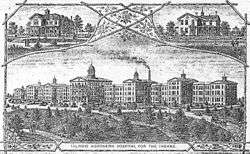
The Kirkbride Plan refers to a system of mental asylum design advocated by Philadelphia psychiatrist Thomas Story Kirkbride (1809-1883) in the mid-19th century.
History
The establishment of state mental hospitals in the U.S. is partly due to reformer Dorothea Dix, who testified to the New Jersey legislature in 1844, vividly describing the state's treatment of people with mental illness; they were being housed in county jails, private homes, and the basements of public buildings. Dix's effort led to the construction of the New Jersey State Lunatic Asylum, the first complete asylum built on the Kirkbride Plan.
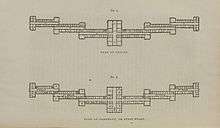
Kirkbride developed his requirements based on a philosophy of Moral Treatment. The typical floor plan, with long rambling wings arranged en echelon (staggered, so each connected wing received sunlight and fresh air), was meant to promote privacy and comfort for patients. The building form itself was meant to have a curative effect, "a special apparatus for the care of lunacy, [whose grounds should be] highly improved and tastefully ornamented." The idea of institutionalization was thus central to Kirkbride's plan for effectively treating patients with mental illnesses.[1]
The asylums tended to be large, imposing, Victorian-era institutional buildings within extensive surrounding grounds, which often included farmland, sometimes worked by patients as part of physical exercise and therapy. While the vast majority were located in the United States, similar facilities were built in Canada, and a psychiatric hospital in Australia was influenced by Kirkbride's recommendations. By 1900 the notion of "building-as-cure" was largely discredited, and in the following decades these large facilities became too expensive to maintain. Many Kirkbride Plan asylums still stand today. Most are abandoned, neglected, and vandalized, though several are still in use or have been renovated for uses other than mental health care.
Notable Kirkbride hospitals

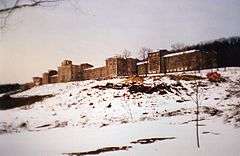
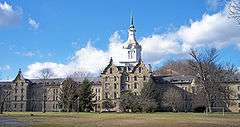
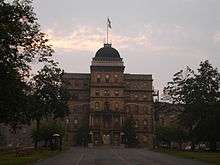
- Completed 1848 New Jersey State Hospital at Trenton, New Jersey, the first Kirkbride Plan building[2]
- 1848, 1880s Central State Hospital at Indianapolis, Indiana (One Kirkbride Plan building, the Department for Women (1878), which was demolished in the 1970s.
- 1848 Jacksonville State Hospital at Jacksonville, Illinois (demolished in the 20th century)
- 1851 Pennsylvania State Lunatic Hospital at Harrisburg, Pennsylvania (Kirkbride Plan building demolished in 1893)
- 1853 Taunton State Hospital at Taunton, Massachusetts (demolished in 2009)
- 1854, 1867 Western State Hospital at Hopkinsville, Kentucky (destroyed by fire in 1861, rebuilt within original exterior walls)
- 1855 Mississippi Lunatic Asylum at Jackson, Mississippi, renamed Mississippi State Insane Hospital in 1900, moved in 1935 and became Mississippi State Hospital. The University of Mississippi Medical Center now stands on the site.
- 1855 Dayton State Hospital at Dayton, Ohio (renovated and used as assisted living)
- 1855 Government Hospital for the Insane at Washington, D.C. (closed in 1987, under renovation since 2014)
- 1856 Austin State Hospital in Austin, Texas listed on the National Register of Historic Places and serving as administrative offices
- 1858 Northampton State Lunatic Hospital at Northampton, Massachusetts (demolished in 2007)
- 1859 The Institute of the Pennsylvania Hospital (Kirkbride's Hospital) at Philadelphia, Pennsylvania
- 1859 Kalamazoo Regional Psychiatric Hospital at Kalamazoo, Michigan (demolished)
- 1859 Bryce Hospital at Tuscaloosa, Alabama (sold to the adjacent University of Alabama and restored)
- 1862 Dixmont State Hospital at Pittsburgh, Pennsylvania (demolished in late 2005)
- 1863 Trans-Allegheny Lunatic Asylum at Weston, West Virginia (undergoing restoration)
- 1865 Mount Pleasant State Hospital at Mount Pleasant, Iowa (Closed and demolished after a fire)
- 1868 Hudson River State Hospital for the Insane at Poughkeepsie, New York
- 1869 Anna State Hospital at Anna, Illinois (only administration section remains and is in use)
- 1869 Central State Hospital at Anchorage, Kentucky (demolished 1996)
- 1869 Danville State Hospital at Danville, Pennsylvania
- 1870–90 Buffalo State Hospital at Buffalo, New York (designed by H.H. Richardson)
- 1872 Maryland Hospital for the Insane at Catonsville, Maryland (demolished in 1963)
- 1872 Northern Illinois State Mental Hospital at Elgin, Illinois (demolished in 1993[3][4])
- 1873 Winnebago State Hospital at Oshkosh, Wisconsin (original Kirkbride demolished in stages between 1950–1969)
- 1873 Independence State Hospital at Independence, Iowa (still in operation and preserved.)
- 1874 Athens Lunatic Asylum at Athens, Ohio (renovated and reused by Ohio University)
- 1874 Warren State Hospital at Warren, Pennsylvania[5][6] (still in use)
- 1875 Broughton Hospital at Morganton, North Carolina (still in use)[7]
- 1876 Greystone Park Psychiatric Hospital at Hanover, New Jersey (Kirkbride Plan building slated for demolition April 2015).
- 1876 Napa State Hospital at Napa, California (Kirkbride demolished in 1949, hospital with new buildings still in use)
- 1877 Worcester State Hospital at Worcester, Massachusetts (partially demolished in 2008 - currently being rebuilt as a non-Kirkbride Plan hospital)[8]
- 1878 Danvers State Hospital at Danvers, Massachusetts (demolished in 2006)[9]
- 1878 Eastern Michigan Asylum for the Insane at Pontiac, Michigan (demolished in 2000)
- 1879 Kankakee State Hospital at Kankakee, Illinois (still in use)
- 1883 Oregon State Hospital at Salem, Oregon (partially still in operation; health care operations transitioning to new facility as of 2010.)
- 1883 Arkansas State Hospital at Little Rock, Arkansas (Kirkbride building demolished between 1948 and 1952.)[10] [11]
- 1884 Clarinda State Hospital at Clarinda, Iowa (still in use and preserved)
- 1885 Northern Michigan Asylum for the Insane at Traverse City, Michigan (partially renovated and in use as condos and businesses)[12]
- 1885 Agnews Developmental Center at Santa Clara, CA (destroyed 1906, rebuilt 1911, partly demolished 1997-2010; the 1911 central building remains but bears little resemblance to a Kirkbride plan anymore; since 2010 the campus hosts offices for Oracle Corporation)
- 1890 Cherokee Mental Health Institute at Cherokee, Iowa (still in use)
- 1891 Sheppard Pratt Hospital at Towson, Maryland (still in use)
- 1891 Eastern State Hospital at Medical Lake, Washington (building torn down, hospital with new building still in use)
- 1895 Fergus Falls Regional Treatment Center at Fergus Falls, Minnesota (not in use, owned by city)[13][14]
References
- ↑ Carla Yanni, The Architecture of Madness: Insane Asylums in the United States, Minneapolis: Minnesota University Press, 2007, 55-59
- ↑ Yanni, Architecture of Madness, 55.
- ↑ http://www.encyclopedia.chicagohistory.org/pages/420.html Retrieved Sept. 22, 2006
- ↑ Briska, William H. (1997). The History of Elgin Mental Health Center: Evolution of a State Hospital. Crossroads Communications. ISBN 0-916445-45-3.
- ↑ 41°52′46″N 79°08′46″W / 41.879503°N 79.146028°W
- ↑ https://web.archive.org/web/20070426064700/http://www.dpw.state.pa.us/Family/MentalHealthServ/StateMentalHospAndRest/003670893.htm. Archived from the original on April 26, 2007. Retrieved June 7, 2007. Missing or empty
|title=(help) - ↑ Broughton Hospital
- ↑
- ↑
- ↑ http://www.encyclopediaofarkansas.net/encyclopedia/entry-detail.aspx?entryID=2238 Retrieved Aug. 21, 2010
- ↑ http://www.historicaerials.com/aerials.php?scale=322&lon=-122.26563869715945&lat=38.2771273594041&year=1948 Retrieved Dec. 28, 2014
- ↑
- ↑ Minnesota Historical Society. Fergus Falls State Hospital Papers
- ↑ Fergus Falls Daily Journal. (September 13, 2008). State Hospital: The Early days
External links
| Wikimedia Commons has media related to Kirkbride Plan hospitals. |
- Kirkbride Buildings — history and photography
- Historic Asylums — history and photography
- Photos of Abandoned Kirkbride Buildings
- Danvers State Hospital — history and photography
- Northampton State Hospital — hospital history and photography
- Asylum Projects — historical wiki archive
- Hudson River State Hospital — hospital history and photography
- Kirkbride Hospitals at Architecture of the State
- Dixmont State Hospital — History and photography
- Danvers State Hospital — History, photography, archives
- Kirkbrides HD — Videography
- Greystone Photo Album, circa 1899, Morris Plains, N.J. - history and photography (Morristown and Morris Township Public Library, N.J.)
Further reading
- The Art of Asylum-Keeping — by Nancy Tomes
- The Architecture of Madness: Insane Asylums in the United States — by Carla Yanni, Minneapolis: Minnesota University Press, 2007.